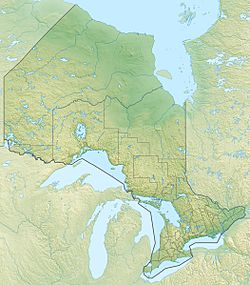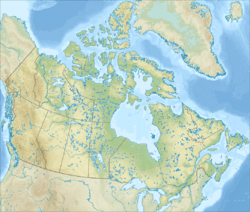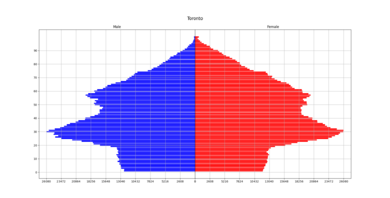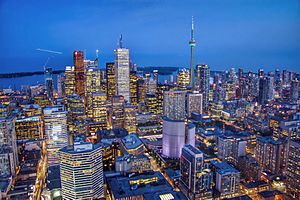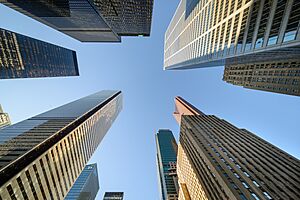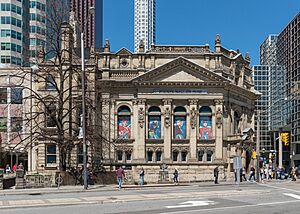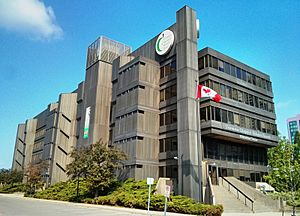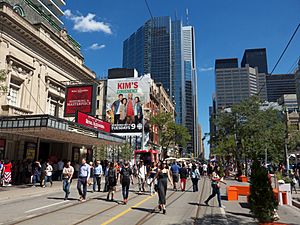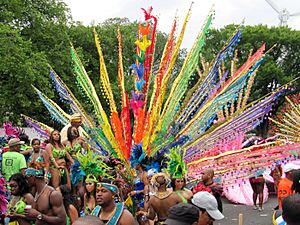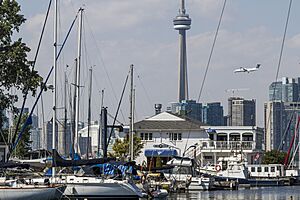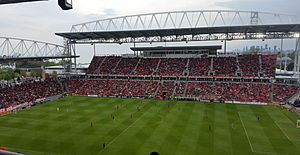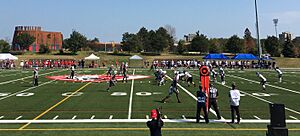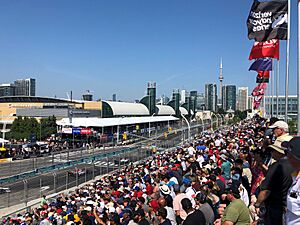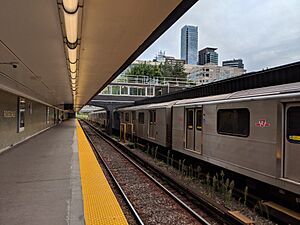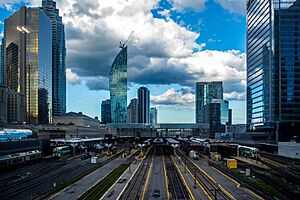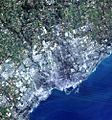Toronto facts for kids
Quick facts for kids
Toronto
|
|||||
|---|---|---|---|---|---|
| City of Toronto | |||||
|
|
|||||
|
|||||
| Etymology: From the Mohawk word tkaronto, the name of a channel between Lakes Simcoe and Couchiching | |||||
| Nicknames:
See list
|
|||||
| Motto(s):
Diversity Our Strength
|
|||||
|
OpenStreetMap
|
|||||
| Country | Canada | ||||
| Province | Ontario | ||||
| Region | Southern Ontario | ||||
| Established | August 27, 1793 (as York) | ||||
| Incorporated | March 6, 1834 (as City of Toronto) | ||||
| Amalgamated into division | January 20, 1953 (as Metropolitan Toronto) | ||||
| Amalgamated | January 1, 1998 (as current City of Toronto) | ||||
| Communities |
|
||||
| Government | |||||
| • Type | Single-tier municipality with a mayor–council system | ||||
| • Body | Toronto City Council | ||||
| Area
|
|||||
| • City | 630.20 km2 (243.32 sq mi) | ||||
| • Urban | 1,792.99 km2 (692.28 sq mi) | ||||
| • Metro | 5,905.71 km2 (2,280.21 sq mi) | ||||
| Elevation | 76.5 m (251.0 ft) | ||||
| Population
(2021)
|
|||||
| • City | 2,794,356 (1st) | ||||
| • Rank | 4th in North America 1st in Canada |
||||
| • Density | 4,427.8/km2 (11,468/sq mi) | ||||
| • Metro | 6,202,225 (1st) | ||||
| • Region | 9,765,188 | ||||
| Demonym(s) | Torontonian | ||||
| Time zone | UTC−05:00 (EST) | ||||
| • Summer (DST) | UTC−04:00 (EDT) | ||||
| Postal code span |
M
|
||||
| Area codes | 416, 647, 437 | ||||
| GDP (Toronto CMA) | CA$430.9 billion (2020) | ||||
| GDP per capita (Toronto CMA) | CA$62,873 (2019) | ||||
Toronto is the largest city in Canada by population and the capital of the Canadian province of Ontario. In 2021, it had a population of over 2.7 million people. This makes it the fourth-largest city in North America. Toronto is a major hub for business, finance, arts, and sports. It is also known as one of the most multicultural cities in the world.
Indigenous people lived in the Toronto area for more than 10,000 years. The land has many rivers, deep valleys, and forests. In 1793, the British started a town called York. This town became the capital of Upper Canada. During the War of 1812, American troops attacked York. In 1834, York was renamed and became the City of Toronto. In 1867, it became the capital of Ontario. The city has grown a lot since then, covering an area of about 630 square kilometers.
Many people from all over the world have moved to Toronto. About half of its residents were born outside Canada. Over 200 different ethnic groups live here. Most people speak English, but over 160 languages are spoken in the city. The mayor of Toronto leads the city. The Toronto City Council has 25 councillors who represent different areas.
Toronto is a big center for music, theater, and making movies and TV shows. It has many museums and galleries, festivals, and sports activities. Over 43 million tourists visit Toronto each year. The city is famous for its tall buildings, especially the CN Tower. The CN Tower is one of the tallest freestanding structures outside of Asia.
The Toronto Stock Exchange is located here. Toronto is also home to the main offices of Canada's five largest banks. Many big Canadian and international companies have their headquarters in Toronto. The city's economy is very diverse. It is strong in technology, finance, education, and tourism. Toronto is the third-largest technology hub in North America. It is also the fastest-growing tech hub.
Contents
- What's in a Name? The Story of Toronto
- Toronto's Past: A Journey Through Time
- Toronto's Landscape: Geography and Climate
- Who Lives in Toronto? Demographics
- Toronto's Economy: How the City Works
- Learning in Toronto: Education
- Community Resources
- Toronto's Culture and Fun
- Sports in Toronto
- Getting Around: Transportation in Toronto
- Global Connections: Toronto's Sister Cities
- Images for kids
- See also
What's in a Name? The Story of Toronto
The name Toronto has been spelled in different ways over time. These include Tarento, Tarontha, and Taronto. The word Taronto first referred to 'The Narrows'. This was a water channel between Lake Simcoe and Lake Couchiching. The Huron people had planted trees there to catch fish.
The Mohawk called this place tkaronto. It means 'where there are trees standing in the water'. This name was first written down in 1615. The word Toronto also means 'plenty' in the Huron language. This was noted in a French book from 1632. A path from Lake Ontario to Lake Huron passed through this area. It was called the Toronto Carrying-Place Trail. This helped the name become widely used.
Most people in Toronto say the city's name as "tuh-RONT-oh". Locals sometimes say it faster, like "tuh-RON-oh" or "TRA-noh". They often don't pronounce the second 't'.
Toronto's Past: A Journey Through Time
Early Days Before 1800
When Europeans first arrived, the Iroquois people lived in the Toronto area. They had taken over from the Wyandot (Huron) people. The name Toronto likely comes from the Iroquois word tkaronto. It means "place where trees stand in the water". This refers to the northern part of Lake Simcoe. The Huron people planted tree saplings there to catch fish.
In the 1660s, the Iroquois built two villages in what is now Toronto. One was called Ganatsekwyagon on the Rouge River. The other was Teiaiagon on the Humber River. By 1701, the Mississauga people had moved into the area. The Iroquois left the Toronto region after the Beaver Wars.
French traders built Fort Rouillé in 1750. It was located where the Exhibition grounds are today. But they left the fort in 1759. During the American Revolutionary War, many British settlers came to the area. They were called United Empire Loyalists. They fled from the United States to British-controlled lands.
In 1787, the British made a deal with the Mississaugas. This was called the Toronto Purchase. They gained over 1,000 square kilometers of land. In 1793, Governor John Graves Simcoe started the town of York. He named it after Prince Frederick, Duke of York. Simcoe moved the capital of Upper Canada to York. He thought it would be safer from attacks by the United States. The York garrison was built at the entrance to the town's natural harbor.
Growth and Change: 1800 to 1945
In 1813, during the War of 1812, American forces attacked York. This was called the Battle of York. They captured and looted the town. American soldiers destroyed much of the fort and burned the parliament buildings. This attack led British troops to burn Washington later in the war.
York officially became the City of Toronto on March 6, 1834. It went back to its original Indigenous name. The city's population was about 9,000 people. This included escaped African American slaves. Some were brought by the Loyalists. Toronto welcomed people of color into its society. Slavery was completely banned in Upper Canada in 1834.
William Lyon Mackenzie became Toronto's first Mayor. He led a rebellion in 1837 against the British government. This rebellion was not successful. Toronto grew quickly as many immigrants arrived. The first large group came during the Irish Potato Famine. Many Irish people, mostly Catholic, moved to the city. By 1851, Irish-born people were the largest ethnic group.
Toronto was the capital of the united Province of Canada twice. First from 1849 to 1852, and again from 1856 to 1858. After that, Quebec became the capital. Since 1867, Toronto has been the capital of Ontario. The government building is at Queen's Park.
In the 19th century, Toronto built a large sewage system. Streets were lit with gas lamps. Long-distance railway lines were built. One line connected Toronto with the Great Lakes in 1854. The Grand Trunk Railway and the Northern Railway of Canada built the first Union Station. Railways brought many more immigrants, trade, and industries. This made Toronto a major link between the world and North America.
Toronto became the biggest center for making alcohol in North America. The Gooderham and Worts Distillery was the world's largest whiskey factory by the 1860s. Part of this old industry can still be seen in the Distillery District. The harbor helped bring in grain and sugar. Expanding port and rail lines brought in timber and coal. Industry was very important along the waterfront for 100 years.
Horse-drawn streetcars were replaced by electric streetcars in 1891. The city gave the transit system to the Toronto Railway Company. In 1921, the public took over the system. It was called the Toronto Transportation Commission. Later, it became the Toronto Transit Commission. This system now has the third-highest number of riders in North America.
The Great Toronto Fire of 1904 destroyed a large part of downtown. But the city was quickly rebuilt. The fire caused over $10 million in damage. It led to stronger fire safety laws and a bigger fire department.
New groups of immigrants arrived from the late 1800s to the early 1900s. These included Germans, French, Italians, and Jews from Eastern Europe. Later came Chinese, Russians, and Poles. Many of these new immigrants lived in crowded areas. One such area was "the Ward". This area is now the financial district. Even with fast growth, Toronto was smaller than Montreal until the 1920s. But by 1934, the Toronto Stock Exchange was the largest in Canada.
Modern Toronto: After 1945
After World War II, many refugees from Europe came to Toronto. Chinese people also came looking for jobs. Construction workers, especially from Italy and Portugal, also arrived. By the late 1960s, immigration policies changed. People from all over the world began to move to Toronto.
Toronto's population grew to over one million by 1951. It doubled to two million by 1971. By the 1980s, Toronto became Canada's largest city. It also became the main economic center. Many companies moved their main offices from Montreal to Toronto. This was partly due to political changes in Quebec.
In 1954, Toronto and 12 nearby towns formed a regional government. It was called Metropolitan Toronto. This was done to help manage services like highways and police. In the same year, Hurricane Hazel hit the city. It brought strong winds and floods. In Toronto, 81 people died. Almost 1,900 families lost their homes. The hurricane caused over $25 million in damage.
In 1967, seven smaller towns in Metropolitan Toronto merged. This created six larger areas. These included the old City of Toronto and areas like East York and North York. In 1998, the provincial government combined all six areas into one city. This created the current City of Toronto. Mel Lastman became the first mayor of this "megacity". John Tory is the current mayor.
On March 6, 2009, Toronto celebrated its 175th birthday as a city. Toronto hosted the G20 summit in June 2010. This was the largest security operation in Canadian history. It also led to the largest mass arrest in Canadian history.
On July 8, 2013, severe floods hit Toronto. This was after intense thunderstorms. Toronto Hydro estimated that 450,000 people lost power. Toronto Pearson International Airport reported 126 mm of rain in five hours. This was more rain than during Hurricane Hazel. In December 2013, Toronto had its worst ice storm. It was as bad as the 1998 Ice Storm. Toronto later hosted WorldPride in 2014 and the Pan American Games in 2015.
Toronto's Landscape: Geography and Climate
Toronto covers an area of about 630 square kilometers. It is 21 km from north to south and 43 km from east to west. It has a 46 km long shoreline on Lake Ontario. The Toronto Islands and Port Lands stretch into the lake. This creates a somewhat sheltered Toronto Harbour south of downtown. The city's boundaries are Lake Ontario to the south. To the west are Etobicoke Creek and Highway 427. Steeles Avenue is to the north. The Rouge River and the Scarborough-Pickering Townline are to the east.
Toronto's Natural Features
The city is mostly flat or has gentle hills. The land slopes gently upwards away from the lake. Many ravines cut through the flat land. These are formed by creeks and three rivers: the Humber River in the west, the Don River east of downtown, and the Rouge River in the east. Most ravines and valleys are now parks. There are also recreational trails along them.
Toronto has many bridges over its ravines. Large bridges like the Prince Edward Viaduct were built to cross wide river valleys. Toronto is not very hilly, but its elevation increases away from the lake. The lowest point is 75 meters above sea level at Lake Ontario. The highest point is 209 meters above sea level near York University. This is at the intersection of Keele Street and Steeles Avenue.
Another important feature is Toronto's escarpments. These are steep slopes that mark the edge of an ancient lake. This lake, called Glacial Lake Iroquois, covered parts of Toronto during the last ice age. The escarpments are most visible at the Scarborough Bluffs. Other parts can be seen near St. Clair Avenue West and north of Davenport Road. The Casa Loma castle sits on top of one of these escarpments.
The lake shore has changed a lot since Toronto was first settled. Much of the land on the north side of the harbor is landfill. This was filled in during the late 1800s. The Port Lands area was a wetland that was filled in during the early 1900s. The shoreline from the harbor west to the Humber River has also been extended into the lake.
The Toronto Islands were once connected to the mainland. But a storm in 1858 cut them off, creating a channel. The Don River used to flow into a wetland. Today, it flows into the harbor through a concrete channel.
Toronto's Weather
Toronto has a humid continental climate. This means it has warm, humid summers and cold winters. The city experiences four clear seasons. The weather can change quickly from day to day. Because it's a big city and close to the lake, Toronto has smaller temperature changes between day and night. Nights are warmer in the city than in rural areas.
In spring and early summer, it can be cooler near the lake. This is because the lake water is cold. These "lake breezes" bring relief on hot summer days. Other lake effects include lake-effect snow and fog.
Winters are cold with frequent snow. Temperatures are usually below 0°C. Sometimes, temperatures drop below -10°C, feeling even colder with wind. Occasionally, they can go below -25°C. Snowstorms can disrupt travel. But mild periods also happen, melting the snow.
Summers are very warm. Daytime temperatures are usually above 20°C. They often go above 30°C, sometimes even above 35°C with high humidity. Spring and autumn are transition seasons. They have mild or cool temperatures with both dry and wet periods.
Rainfall is spread out through the year. Summer is usually the wettest season, with most rain falling during thunderstorms. Long dry periods are rare. Toronto gets about 2,066 hours of sunshine each year. This is 45% of daylight hours. It ranges from 28% in December to 60% in July.
| Climate data for Toronto (The Annex), 1981–2010 normals, extremes 1840–present | |||||||||||||
|---|---|---|---|---|---|---|---|---|---|---|---|---|---|
| Month | Jan | Feb | Mar | Apr | May | Jun | Jul | Aug | Sep | Oct | Nov | Dec | Year |
| Record high °C (°F) | 16.1 (61.0) |
19.1 (66.4) |
26.7 (80.1) |
32.2 (90.0) |
34.4 (93.9) |
36.7 (98.1) |
40.6 (105.1) |
38.9 (102.0) |
37.8 (100.0) |
30.8 (87.4) |
23.9 (75.0) |
19.9 (67.8) |
40.6 (105.1) |
| Mean daily maximum °C (°F) | −0.7 (30.7) |
0.4 (32.7) |
4.7 (40.5) |
11.5 (52.7) |
18.4 (65.1) |
23.8 (74.8) |
26.6 (79.9) |
25.5 (77.9) |
21.0 (69.8) |
14.0 (57.2) |
7.5 (45.5) |
2.1 (35.8) |
12.9 (55.2) |
| Daily mean °C (°F) | −3.7 (25.3) |
−2.6 (27.3) |
1.4 (34.5) |
7.9 (46.2) |
14.1 (57.4) |
19.4 (66.9) |
22.3 (72.1) |
21.5 (70.7) |
17.2 (63.0) |
10.7 (51.3) |
4.9 (40.8) |
−0.5 (31.1) |
9.4 (48.9) |
| Mean daily minimum °C (°F) | −6.7 (19.9) |
−5.6 (21.9) |
−1.9 (28.6) |
4.1 (39.4) |
9.9 (49.8) |
14.9 (58.8) |
18.0 (64.4) |
17.4 (63.3) |
13.4 (56.1) |
7.4 (45.3) |
2.3 (36.1) |
−3.1 (26.4) |
5.9 (42.6) |
| Record low °C (°F) | −32.8 (−27.0) |
−31.7 (−25.1) |
−26.7 (−16.1) |
−15.0 (5.0) |
−3.9 (25.0) |
−2.2 (28.0) |
3.9 (39.0) |
4.4 (39.9) |
−2.2 (28.0) |
−8.9 (16.0) |
−20.6 (−5.1) |
−30.0 (−22.0) |
−32.8 (−27.0) |
| Average precipitation mm (inches) | 61.5 (2.42) |
55.4 (2.18) |
53.7 (2.11) |
68.0 (2.68) |
82.0 (3.23) |
70.9 (2.79) |
63.9 (2.52) |
81.1 (3.19) |
84.7 (3.33) |
64.4 (2.54) |
84.1 (3.31) |
61.5 (2.42) |
831.1 (32.72) |
| Average rainfall mm (inches) | 29.1 (1.15) |
29.7 (1.17) |
33.6 (1.32) |
61.1 (2.41) |
82.0 (3.23) |
70.9 (2.79) |
63.9 (2.52) |
81.1 (3.19) |
84.7 (3.33) |
64.3 (2.53) |
75.4 (2.97) |
38.2 (1.50) |
714.0 (28.11) |
| Average snowfall cm (inches) | 37.2 (14.6) |
27.0 (10.6) |
19.8 (7.8) |
5.0 (2.0) |
0.0 (0.0) |
0.0 (0.0) |
0.0 (0.0) |
0.0 (0.0) |
0.0 (0.0) |
0.1 (0.0) |
8.3 (3.3) |
24.1 (9.5) |
121.5 (47.8) |
| Average precipitation days (≥ 0.2 mm) | 15.4 | 11.6 | 12.6 | 12.6 | 12.7 | 11.0 | 10.4 | 10.2 | 11.1 | 11.7 | 13.0 | 13.2 | 145.5 |
| Average rainy days (≥ 0.2 mm) | 5.4 | 4.8 | 7.9 | 11.2 | 12.7 | 11.0 | 10.4 | 10.2 | 11.1 | 11.7 | 10.9 | 7.0 | 114.1 |
| Average snowy days (≥ 0.2 cm) | 12.0 | 8.7 | 6.5 | 2.2 | 0.0 | 0.0 | 0.0 | 0.0 | 0.0 | 0.08 | 3.1 | 8.4 | 40.9 |
| Mean monthly sunshine hours | 85.9 | 111.3 | 161.0 | 180.0 | 227.7 | 259.6 | 279.6 | 245.6 | 194.4 | 154.3 | 88.9 | 78.1 | 2,066.3 |
| Percent possible sunshine | 29.7 | 37.7 | 43.6 | 44.8 | 50.0 | 56.3 | 59.8 | 56.7 | 51.7 | 45.1 | 30.5 | 28.0 | 44.5 |
| Source: Environment Canada | |||||||||||||
Who Lives in Toronto? Demographics
| Population history of Toronto | ||
|---|---|---|
| Year | Pop. | ±% |
| 1834 | 9,252 | — |
| 1841 | 14,249 | +54.0% |
| 1851 | 30,776 | +116.0% |
| 1861 | 44,821 | +45.6% |
| 1871 | 56,092 | +25.1% |
| 1881 | 86,415 | +54.1% |
| 1891 | 144,023 | +66.7% |
| 1901 | 238,080 | +65.3% |
| 1911 | 381,383 | +60.2% |
| 1921 | 521,893 | +36.8% |
| 1931 | 856,955 | +64.2% |
| 1941 | 951,549 | +11.0% |
| 1951 | 1,176,622 | +23.7% |
| 1961 | 1,824,481 | +55.1% |
| 1971 | 2,089,729 | +14.5% |
| 1976 | 2,124,291 | +1.7% |
| 1981 | 2,137,395 | +0.6% |
| 1986 | 2,192,721 | +2.6% |
| 1991 | 2,275,771 | +3.8% |
| 1996 | 2,385,421 | +4.8% |
| 2001 | 2,481,494 | +4.0% |
| 2006 | 2,503,281 | +0.9% |
| 2011 | 2,615,060 | +4.5% |
| 2016 | 2,731,571 | +4.5% |
| 2021 | 2,794,356 | +2.3% |
In the 2021 Census, Toronto's population was 2,794,356. This was a 2.3% increase from 2016. The city covers 631.1 square kilometers. This means it had about 4,427.8 people per square kilometer in 2021.
The larger Toronto area, called the Census Metropolitan Area (CMA), had 6,202,225 people in 2021. This area covers 5,902.75 square kilometers.
In 2016, 14.5% of the population was 14 years old or younger. People aged 65 and over made up 15.6%. The average age was 39.3 years. The city has slightly more females (52%) than males (48%). Women outnumber men in all age groups 15 and older.
The 2021 census showed that 1,286,145 people in Toronto were born outside Canada. This is about 46.6% of the population. The top countries of origin for immigrants were the Philippines, China, and India. Toronto has the second-highest percentage of foreign-born people among world cities. No single nationality or culture dominates Toronto's immigrant population. This makes it one of the most diverse cities in the world.
Diverse Backgrounds: Race and Ethnicity
In 2016, the most common ethnic backgrounds were Chinese (12.5%), English (12.3%), and Canadian (12.0%). About 47.9% of people had European backgrounds. 40.1% had Asian (including Middle-Eastern) backgrounds.
In 2016, 51.5% of Toronto residents belonged to a visible minority group. This was up from 13.6% in 1981. The largest visible minority groups were South Asian (12.6%), East Asian (12.5%), and Black (8.9%). It is expected that visible minorities will make up 63% of the city's population by 2031.
Toronto's diversity is seen in its many ethnic neighborhoods. These include Chinatown, Corso Italia, Greektown, Kensington Market, Koreatown, Little India, Little Italy, Little Jamaica, Little Portugal, and Roncesvalles (Polish community).
| Panethnic group | 2021 | 2016 | 2011 | 2006 | 2001 | |||||||||
|---|---|---|---|---|---|---|---|---|---|---|---|---|---|---|
| Pop. | % | Pop. | % | Pop. | % | Pop. | % | Pop. | % | |||||
| European | 1,201,075 | 43.5% | 1,282,750 | 47.66% | 1,292,365 | 50.17% | 1,300,330 | 52.51% | 1,394,310 | 56.75% | ||||
| South Asian | 385,440 | 13.96% | 338,965 | 12.59% | 317,100 | 12.31% | 298,370 | 12.05% | 253,920 | 10.34% | ||||
| East Asian | 351,625 | 12.73% | 354,510 | 13.17% | 327,930 | 12.73% | 329,260 | 13.3% | 301,060 | 12.25% | ||||
| Black | 265,005 | 9.6% | 239,850 | 8.91% | 218,160 | 8.47% | 208,555 | 8.42% | 204,075 | 8.31% | ||||
| Southeast Asian | 224,260 | 8.12% | 194,360 | 7.22% | 179,270 | 6.96% | 140,050 | 5.66% | 120,330 | 4.9% | ||||
| Middle Eastern | 111,360 | 4.03% | 96,355 | 3.58% | 79,155 | 3.07% | 65,240 | 2.63% | 59,560 | 2.42% | ||||
| Latin American | 92,455 | 3.35% | 77,160 | 2.87% | 71,205 | 2.76% | 64,855 | 2.62% | 54,350 | 2.21% | ||||
| Indigenous | 22,925 | 0.83% | 23,065 | 0.86% | 19,265 | 0.75% | 13,605 | 0.55% | 11,370 | 0.46% | ||||
| Other/Multiracial | 107,135 | 3.88% | 84,650 | 3.14% | 71,590 | 2.78% | 56,295 | 2.27% | 57,840 | 2.35% | ||||
| Total: Visible minority | 1,537,280 | 55.7% | 1,385,850 | 51.5% | 1,264,410 | 49.1% | 1,162,625 | 47% | 1,062,505 | 42.8% | ||||
| Total responses | 2,761,285 | 98.82% | 2,691,665 | 98.54% | 2,576,025 | 98.51% | 2,476,565 | 98.93% | 2,456,805 | 99.01% | ||||
| Total population | 2,794,356 | 100% | 2,731,571 | 100% | 2,615,060 | 100% | 2,503,281 | 100% | 2,481,494 | 100% | ||||
| Note: Totals greater than 100% due to multiple origin responses | ||||||||||||||
Beliefs and Religions
In 2011, Christianity was the most common religion in Toronto. About 54.1% of people were Christian. Most of them were Catholic (28.2%). Other Christian groups included Protestants (11.9%) and Christian Orthodox (4.3%).
Other religions practiced in the city include Islam (8.2%), Hinduism (5.6%), Judaism (3.8%), Buddhism (2.7%), and Sikhism (0.8%). About 24.2% of Toronto's population reported having no religious affiliation.
Languages Spoken in Toronto
English is the main language in Toronto. About 95% of residents can speak English well. However, only 54.7% of Torontonians said English was their first language. Canada has two official languages: English and French. About 1.6% of Torontonians speak French as their first language. But 9.1% can speak both official languages.
Toronto is home to many other languages. City services, like 9-1-1 emergency calls, can help in over 150 languages. In 2001, after English, Chinese languages and Italian were the most spoken languages at work. In 2016, about 55% of people who spoke a Chinese language reported speaking Mandarin.
Toronto's Economy: How the City Works
Toronto is a global center for business and finance. It is often seen as Canada's financial and industrial capital. Many banks and brokerage firms are located on Bay Street in the Financial District. The Toronto Stock Exchange is the seventh-largest stock exchange in the world. Canada's five largest banks, known as the Big Five, have their main offices in Toronto.
The city is also important for media, publishing, and technology. It is home to major Canadian TV networks and media companies. Many other large Canadian and international companies are in the Greater Toronto Area. These include Magna International and Manulife.
Even though much of the manufacturing is outside the city, Toronto is a key point for trade. Its location along the Quebec City–Windsor Corridor helps support industries. These include making cars, iron, steel, and food. The St. Lawrence Seaway opened in 1959. This allowed ships to reach the Great Lakes from the Atlantic Ocean.
Toronto's economy is growing steadily. Many companies are moving their Canadian headquarters here. This has led to a boom in real estate. Toronto has some of the most expensive real estate in Canada and the world.
Bay Street: Canada's Financial Heart
Toronto's Financial District is centered on Bay Street. This street is like Wall Street in New York. All five of Canada's largest banks have their main offices here. These are Royal Bank of Canada, Toronto-Dominion Bank, Scotiabank, Bank of Montreal, and Canadian Imperial Bank of Commerce. Toronto's banking system was ranked the safest in the world from 2007 to 2014.
Media and Entertainment Hub
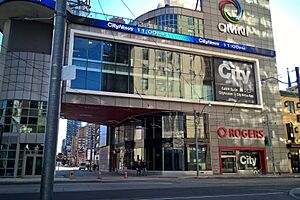
Toronto is Canada's largest media market. It has four main daily newspapers and three free commuter papers. The Toronto Star and the Toronto Sun are the main city newspapers. National newspapers like The Globe and Mail are also based here. Many magazines are produced in Toronto, such as Canadian Business and Maclean's.
Toronto is home to the main offices of major English-language Canadian TV networks. These include CBC, CTV, and Global. Music TV channels like Much and MTV Canada are also based in the city.
Toronto on Screen: Film Production

Toronto is a major center for Canada's film and television industry. This is partly because it's cheaper to produce films in Canada. The city's streets and famous places are seen in many movies. They often look like American cities such as Chicago or New York. Toronto offers many different places to film. The city's Film and Television Office helps with production. Toronto's film industry also extends to nearby cities like Hamilton.
Technology and Biotech Growth
Toronto is a big hub for the technology industry. It generates $52 billion in revenue each year. In 2017, Toronto tech companies offered almost 30,000 jobs. This was more than San Francisco Bay Area, Seattle, and Washington, D.C. combined. The area between Toronto, Waterloo, and Hamilton is called a "digital corridor." It has many tech companies and jobs, similar to Silicon Valley. Toronto has a large startup community. It is the third-largest center for information and communications technology in North America. In 2023, it was ranked the 17th best startup scene globally.
Tourism in Toronto

In 2018, 27.5 million tourists visited Toronto. This brought in $10.3 billion for the economy. The Toronto Eaton Centre gets over 47 million visitors each year. Other popular shopping areas include the Path network. This is the world's largest underground shopping complex. Kensington Market and St. Lawrence Market are also popular.
The Toronto Islands are close to downtown. No private cars are allowed there, except for the airport. Other tourist spots include the CN Tower and Casa Loma. Toronto's theaters, Yonge–Dundas Square, and Ripley's Aquarium of Canada also attract visitors.
The Royal Ontario Museum is a museum of world culture and natural history. The Toronto Zoo has over 5,000 animals from more than 460 species. The Art Gallery of Ontario has a large collection of Canadian, European, and modern art. It also hosts exhibits from museums worldwide. The Gardiner Museum is Canada's only museum dedicated to ceramics. It has over 2,900 ceramic works. The city also has the Ontario Science Centre, the Bata Shoe Museum, and the Textile Museum of Canada.
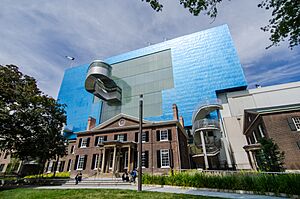
Other art galleries and museums include the Design Exchange and the TIFF Lightbox. The city also runs its own museums, like the Spadina House. The Don Valley Brick Works is a former industrial site. It was partly restored as a park and heritage site in 1996. The Canadian National Exhibition ("The Ex") is held every summer. It is the oldest annual fair in the world. The Ex gets about 1.25 million visitors.
Popular shopping areas include Yorkville, Queen West, and Harbourfront. The Eaton Centre is Toronto's most popular tourist attraction. It gets over 52 million visitors annually.
Greektown on the Danforth hosts the annual "Taste of the Danforth" festival. It attracts over one million people in two and a half days. Toronto is also home to Casa Loma. This was the former home of Sir Henry Pellatt. Other notable places include The Beaches, the Toronto Islands, and the Hockey Hall of Fame.
Learning in Toronto: Education
Schools for All Ages
There are four public school boards in Toronto. They provide elementary and secondary education. These are the Conseil scolaire catholique MonAvenir, the Conseil scolaire Viamonde (CSV), the Toronto Catholic District School Board (TCDSB), and the Toronto District School Board (TDSB). CSV and TDSB are public school boards that do not teach religion. MonAvenir and TCDSB are separate public school boards, which means they are linked to a specific religion. CSV and MonAvenir teach in French. TCDSB and TDSB teach in English.
TDSB runs the most schools in Toronto. It has 451 elementary schools and 105 secondary schools. TCDSB has 163 elementary schools and 29 secondary schools. CSV runs 11 elementary schools and three secondary schools. MonAvenir has nine elementary schools and three secondary schools in Toronto.
Beyond High School: Colleges and Universities
Toronto has several public universities and colleges. There are also many other schools. These include The Royal Conservatory of Music and the Canadian Film Centre. Tyndale University is a Christian post-secondary school.
Universities in Toronto
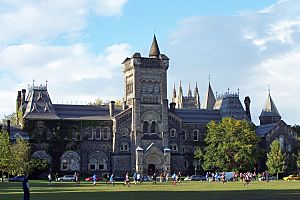
Five public universities are based in Toronto. Four are in downtown Toronto: OCAD University, Toronto Metropolitan University, the Université de l'Ontario français, and the University of Toronto. The University of Toronto also has two other campuses. One is in Scarborough, and the other is in Mississauga. York University is the only Toronto-based university not in downtown. It has a main campus in North York and another in midtown Toronto.
Other universities from Ontario also have campuses or facilities in Toronto. These include Queen's University at Kingston and the University of Ottawa.
Colleges in Toronto
There are four public colleges in Toronto. These are Centennial College, George Brown College, Humber Polytechnic, and Seneca Polytechnic. These colleges have several campuses across the city. Many other public colleges from Ontario also have campuses in Toronto.
Community Resources
Toronto's Public Library System
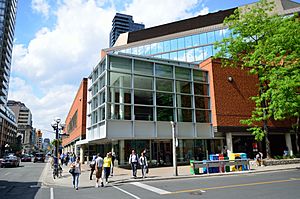
The Toronto Public Library is the largest public library system in Canada. In 2008, it had more books borrowed per person than any other public library system in the world. This makes it the largest neighborhood-based library system globally. It also had the most visitors and books borrowed compared to other large city systems in North America.
The library started in 1830 as the library of the Mechanics' Institute. Today, the Toronto Public Library has 100 branches. It has over 12 million items in its collection.
Toronto's Culture and Fun
Toronto has a lively theater and performing arts scene. It has over fifty ballet and dance companies. There are six opera companies and two symphony orchestras. Many music venues and theaters are also here. The city is home to the National Ballet of Canada and the Canadian Opera Company. The Toronto Symphony Orchestra also performs here.
Famous places for performances include the Four Seasons Centre for the Performing Arts and Roy Thomson Hall. Ontario Place used to have the world's first permanent IMAX movie theater, the Cinesphere. It also has the Budweiser Stage, an outdoor music venue. Ontario Place closed in 2012, but the Budweiser Stage still operates. There are plans to make Ontario Place new again.
Every summer, the Canadian Stage Company puts on a Shakespeare play. It's called "Dream in High Park." Canada's Walk of Fame honors successful Canadians. Stars are placed on sidewalks along King Street and Simcoe Street.
Making movies and TV shows is a big industry here. As of 2011, Toronto was the third-largest production center for film and TV. It's known as "Hollywood North" along with Vancouver. The Toronto International Film Festival is an annual event. It celebrates films from around the world. Another film festival is Take 21. It shows movies made by students aged 12–18.
Toronto's Caribana festival happens every summer from mid-July to early August. It is based on the Trinidad and Tobago Carnival. The first Caribana was in 1967. It celebrated Canada's Centennial. Now, over one million people come to Toronto's Lake Shore Boulevard for it. The festival brings in over $400 million for Ontario's economy.
Pride Week is another big event in the city. It takes place in late June. It is one of the largest LGBTQ+ festivals in the world.
Sports in Toronto
Toronto has teams in five major sports leagues. These are the National Hockey League (NHL), Major League Baseball (MLB), National Basketball Association (NBA), Canadian Football League (CFL), and Major League Soccer (MLS). The city's main sports venues include the Scotiabank Arena, Rogers Centre, and BMO Field. Toronto is one of only six North American cities to have won championships in all five major leagues.
Old sports clubs in Toronto include the Granite Club (1836) and the Royal Canadian Yacht Club (1852).
Professional Sports Teams

Toronto is home to the Toronto Maple Leafs. They are one of the NHL's Original Six teams. The city has a rich history of hockey championships. The Maple Leafs have won 13 Stanley Cup titles. The Toronto Marlies of the American Hockey League also play in Toronto. They are the farm team for the Maple Leafs. The Toronto Six is the city's first Canadian team in the National Women's Hockey League.
The city also has the Toronto Blue Jays MLB baseball team. They have won two World Series titles (1992, 1993). The Blue Jays play their home games at the Rogers Centre.
The Toronto Raptors basketball team joined the NBA in 1995. They won their first NBA title in 2019. The Raptors are the only NBA team with their own TV channel, NBA TV Canada. They play at Scotiabank Arena, which they share with the Maple Leafs. In 2016, Toronto hosted the NBA All-Star game. The Toronto Tempo of the WNBA will start playing in 2026.
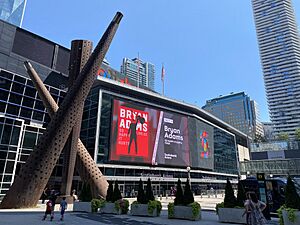
The city's Canadian football team is the CFL's Toronto Argonauts. They were founded in 1873. The club has won 18 Grey Cup championships. Their home games are at BMO Field.
Toronto's soccer team is the Toronto FC MLS team. They have won seven Canadian Championship titles. They also won the MLS Cup in 2017. They share BMO Field with the Toronto Argonauts.
The Toronto Rock is the city's National Lacrosse League team. They won five championships in seven years in the late 1990s and early 2000s. The Rock used to share Scotiabank Arena. But they moved to Hamilton, keeping their Toronto name.
The Toronto Wolfpack became Canada's first professional rugby league team in 2017. They were also the world's first transatlantic professional sports team. The team withdrew from the Super League in 2020 due to travel rules. Now, 'Team Wolfpack' will play in the new North American Rugby League tournament.
Toronto is home to the Toronto Rush, a semi-professional ultimate team. They play in the American Ultimate Disc League (AUDL). The sport of Ultimate (disc) started in Toronto. Over 3300 players compete annually in the Toronto Ultimate Club.
Toronto has hosted several National Football League (NFL) exhibition games. The Buffalo Bills played eight home games in the city from 2008 to 2013.
| Club | League | Sport | Venue | Established | Championships |
|---|---|---|---|---|---|
| Scarborough Shooting Stars | CEBL | Basketball | Toronto Pan Am Sports Centre | 2021 | 0 |
| Toronto Argonauts | CFL | Canadian football | BMO Field | 1873 | 18 (last in 2022) |
| Toronto Arrows | MLR | Rugby union | York Lions Stadium | 2018 | 0 |
| Toronto Blue Jays | MLB | Baseball | Rogers Centre | 1977 | 2 (last in 1993) |
| Toronto FC | MLS | Soccer | BMO Field | 2007 | 1 (last in 2017) |
| Toronto Lady Lynx | USL | Women's soccer | Rob Ford Stadium | 2005 | 0 |
| Toronto Maple Leafs | NHL | Hockey | Scotiabank Arena | 1917 | 13 (last in 1967) |
| Toronto Marlies | AHL | Hockey | Coca-Cola Coliseum | 2005 | 1 (last in 2018) |
| Toronto Raptors | NBA | Basketball | Scotiabank Arena | 1995 | 1 (last in 2019) |
| Toronto Rock | NLL | Box lacrosse | FirstOntario Centre | 1998 | 6 (last in 2011) |
| Toronto Sceptres | PWHL | Hockey | Coca-Cola Coliseum | 2024 | 0 |
| Toronto Tempo | WNBA | Basketball | Coca-Cola Coliseum | 2026 | 0 |
| Toronto Wolfpack | NARL | Rugby league | Lamport Stadium | 2017 | 1 (in 2017 League 1) |
| York United FC | CPL | Soccer | York Lions Stadium | 2018 | 0 |
University and College Sports
The University of Toronto hosted the first recorded college football game in November 1861. Many post-secondary schools in Toronto are part of U Sports (for universities) or the Canadian Collegiate Athletic Association (for colleges).
Toronto used to host the International Bowl. This was an NCAA college football game. It was played at Rogers Centre from 2007 to 2010.
Sporting Events in Toronto
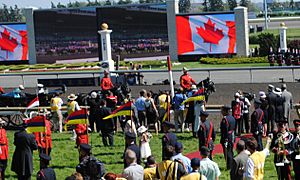
Toronto, along with Montreal, hosts an annual tennis tournament. It's called the Canadian Open. It takes place in July and August.
The city hosts the Toronto Waterfront Marathon every year. This is one of the World Athletics Label Road Races. Toronto also hosts the annual Grand Prix of Toronto car race. This is part of the IndyCar Series. It is held on a street circuit at Exhibition Place. Horse racing events are held at Woodbine Racetrack.
Toronto hosted the 2015 Pan American Games in July 2015. It also hosted the 2015 Parapan American Games in August 2015. These games were the largest multi-sport event ever held in Canada.
Toronto was a candidate city for the 1996 and 2008 Summer Olympics. The city was named one of 16 cities in North America to host matches for the 2026 FIFA World Cup.
Getting Around: Transportation in Toronto

Toronto is a major transportation hub. It has many ways to get around, including highways and public transit. Toronto also has a large network of bicycle lanes and paths.
Public Transit System
The Toronto Transit Commission (TTC) runs Toronto's public transportation. The main part of its system is the Toronto subway. It has three rapid transit lines across the city. These include the U-shaped Line 1, the east-west Line 2, and the short east-west Line 4. Line 1 goes beyond the city limits to Vaughan.
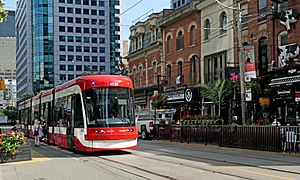
The TTC also runs many buses and streetcars. Streetcars serve downtown, and buses cover areas not reached by the subway. TTC buses and streetcars use the same fare system as the subway. Many subway stations allow easy transfers between trains and surface vehicles.
There are plans to extend the subway and add light-rail lines. Construction on Line 5 Eglinton began in 2011 and is expected to finish by 2024. In 2015, the Ontario government promised to fund Line 6 Finch West, also to be completed by 2024. In 2019, a new transit plan was released. It includes a new 16 km Ontario Line and extensions for other lines.
Toronto's old Union Station is being renovated. This will allow more trains from GO Transit, Via Rail, and Amtrak. A new bus terminal at Union Station is also being built. Toronto's public transit connects to other city networks.
The Government of Ontario runs a regional rail and bus system called GO Transit. It serves the Greater Toronto Area. GO Transit carries over 250,000 passengers every weekday. Most of them travel to or from Union Station. Metrolinx is improving GO Transit. They plan to electrify many rail lines by 2030.
Travel Between Cities
Toronto Union Station is a hub for VIA Rail. It offers train services to different parts of Ontario and to Montreal and Ottawa. Long-distance services also go to Vancouver and New York City.
GO Transit provides bus services from Union Station Bus Terminal. These go to places within the Golden Horseshoe. Other companies also offer long-distance bus services. They connect Toronto to other cities in Ontario, nearby provinces, and the United States. The Toronto Coach Terminal used to be the city's main bus hub. It closed in 2021.
Airports Serving Toronto
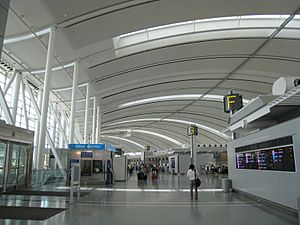
Canada's busiest airport is Toronto Pearson International Airport (YYZ). It is located on the western edge of the city. The Union Pearson Express (UP Express) train connects Pearson International directly to Union Station. This service started in June 2015.
Limited flights to nearby places in Canada and the US are available from Billy Bishop Toronto City Airport (YTZ). This airport is on the Toronto Islands, southwest of downtown. Downsview Airport (YZD) is in the north of the city. It is owned by de Havilland Canada.
Other airports near Toronto include John C. Munro Hamilton International Airport (YHM) and Buffalo Niagara International Airport (BUF). A second international airport is planned northeast of Toronto in Pickering.
Streets and Highways
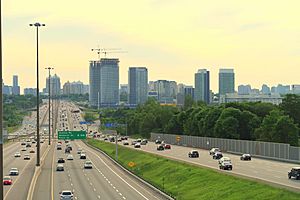
Toronto's main streets are laid out in a grid pattern. Major roads are about 6.6 km apart. East-west roads are generally parallel to Lake Ontario. North-south roads are mostly straight up and down. This pattern is sometimes broken by natural features, like the Don River ravines. Toronto's traffic congestion is one of the highest in North America. It is the second highest in Canada after Vancouver.
Several municipal and provincial highways serve Toronto. Highway 401 cuts through the city from west to east. It is the busiest road in North America. Highway 400 connects the city with Northern Ontario. Highway 404 is an extension of the Don Valley Parkway. The Queen Elizabeth Way (QEW) connects Toronto to Niagara Falls and Buffalo. Main city expressways include the Gardiner Expressway and the Don Valley Parkway.
Global Connections: Toronto's Sister Cities
Partnership Cities
Friendship Cities
- Ho Chi Minh City, Vietnam (2006)
- Kyiv, Ukraine (1992)
- Quito, Ecuador (2006)
- Rio de Janeiro, Brazil (2015)
- Sagamihara, Japan (1991)
- Warsaw, Poland (1990)
Images for kids
See also
 In Spanish: Toronto para niños
In Spanish: Toronto para niños











